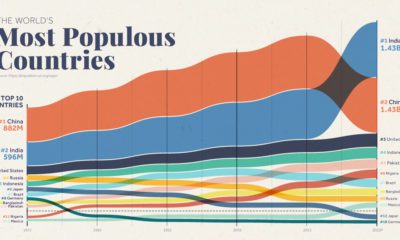For many millennia, it was almost unfathomable for a city to sustain more than 1 million residents. In fact, it wasn’t until the 19th century that the largest cities globally, such as London and Beijing, were able to consistently hold populations beyond that impressive mark. Despite this, in the modern era, we’ve quickly discovered that a city of 1 million people isn’t remarkable at all. In China alone, there are now over 100 cities with a million people today – and as such, our mental benchmark for what we consider to be a “big city” has changed considerably from past times.
Thinking Big
Just like a city the size of modern Tokyo was hard to imagine for someone living in the 19th century, it can be an extremely difficult thought experiment for us to visualize what future megacities will look like. Researchers at the Global Cities Institute have crunched the numbers to provide us with one view of the potential megacities of the future, extrapolating a variety of factors to project a list of the 101 largest cities in the years 2010, 2025, 2050, 2075, and 2100. Today’s video uses this data – it’s also an extension to the previous work we did based on the report here.
The Largest Megacities by 2100
According to the report, human geography will look completely unfamiliar by the turn of the century. Here is a list of the 20 largest megacities projected for 2100: By the year 2100, it’s estimated that 13 of the world’s largest megacities will be located in Africa. Meanwhile, India will hold three of them – and there will be zero of them found in the Americas, China, or Europe. Here’s a final look at the top three: #1: Lagos, Nigeria Nigeria’s largest city, Lagos, is expected to push the limits of how big a metropolis can get. Already, Lagos has seen explosive growth over the past few decades, and is growing so fast that no one really knows how many people live there. Over 2,000 people emigrate to the city every day, and current population estimates vary widely from 11 to 21 million inhabitants. Either way, by the turn of the century, Lagos is projected to have a population north of 88 million. #2: Kinshasa, DRC Kinshasa, the capital of the Democratic Republic of Congo is projected to be the second largest city in the world with a population of 83 million. #3: Dar Es Salaam, Tanzania Dar Es Salaam, a city on the coast of Tanzania, has a population of just 4.4 million today. By 2100, its population is projected to jump by a whopping 1,588%, putting the total at 74 million inhabitants. on Even while political regimes across these countries have changed over time, they’ve largely followed a few different types of governance. Today, every country can ultimately be classified into just nine broad forms of government systems. This map by Truman Du uses information from Wikipedia to map the government systems that rule the world today.
Countries By Type of Government
It’s important to note that this map charts government systems according to each country’s legal framework. Many countries have constitutions stating their de jure or legally recognized system of government, but their de facto or realized form of governance may be quite different. Here is a list of the stated government system of UN member states and observers as of January 2023: Let’s take a closer look at some of these systems.
Monarchies
Brought back into the spotlight after the death of Queen Elizabeth II of England in September 2022, this form of government has a single ruler. They carry titles from king and queen to sultan or emperor, and their government systems can be further divided into three modern types: constitutional, semi-constitutional, and absolute. A constitutional monarchy sees the monarch act as head of state within the parameters of a constitution, giving them little to no real power. For example, King Charles III is the head of 15 Commonwealth nations including Canada and Australia. However, each has their own head of government. On the other hand, a semi-constitutional monarchy lets the monarch or ruling royal family retain substantial political powers, as is the case in Jordan and Morocco. However, their monarchs still rule the country according to a democratic constitution and in concert with other institutions. Finally, an absolute monarchy is most like the monarchies of old, where the ruler has full power over governance, with modern examples including Saudi Arabia and Vatican City.
Republics
Unlike monarchies, the people hold the power in a republic government system, directly electing representatives to form government. Again, there are multiple types of modern republic governments: presidential, semi-presidential, and parliamentary. The presidential republic could be considered a direct progression from monarchies. This system has a strong and independent chief executive with extensive powers when it comes to domestic affairs and foreign policy. An example of this is the United States, where the President is both the head of state and the head of government. In a semi-presidential republic, the president is the head of state and has some executive powers that are independent of the legislature. However, the prime minister (or chancellor or equivalent title) is the head of government, responsible to the legislature along with the cabinet. Russia is a classic example of this type of government. The last type of republic system is parliamentary. In this system, the president is a figurehead, while the head of government holds real power and is validated by and accountable to the parliament. This type of system can be seen in Germany, Italy, and India and is akin to constitutional monarchies. It’s also important to point out that some parliamentary republic systems operate slightly differently. For example in South Africa, the president is both the head of state and government, but is elected directly by the legislature. This leaves them (and their ministries) potentially subject to parliamentary confidence.
One-Party State
Many of the systems above involve multiple political parties vying to rule and govern their respective countries. In a one-party state, also called a single-party state or single-party system, only one political party has the right to form government. All other political parties are either outlawed or only allowed limited participation in elections. In this system, a country’s head of state and head of government can be executive or ceremonial but political power is constitutionally linked to a single political movement. China is the most well-known example of this government system, with the General Secretary of the Communist Party of China ruling as the de facto leader since 1989.
Provisional
The final form of government is a provisional government formed as an interim or transitional government. In this system, an emergency governmental body is created to manage political transitions after the collapse of a government, or when a new state is formed. Often these evolve into fully constitutionalized systems, but sometimes they hold power for longer than expected. Some examples of countries that are considered provisional include Libya, Burkina Faso, and Chad.
















